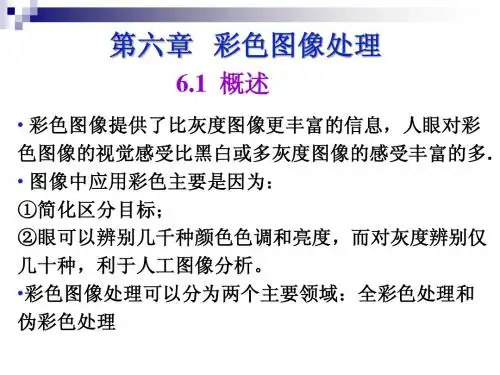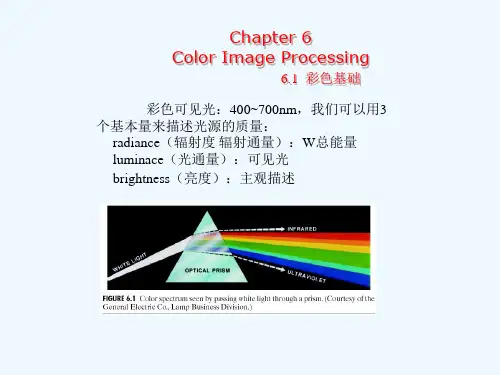第六章 彩色图像处理(1)
- 格式:ppt
- 大小:6.82 MB
- 文档页数:93



第六章图像⾊彩处理第六章图像⾊彩处理本章介绍Photoshop 中的图像⾊彩处理的知识和⽅法。
由于在第⼀章中我们已经学习了图像和⾊彩的基础知识,所以本章不再赘述。
这⾥主要通过介绍图像⾊彩调整命令的知识以及实例来完成这⼀部分知识的学习。
通过本章学习,你可以:◆了解图像⾊彩处理的知识◆理解图像⾊彩调整命令,掌握技巧并学会运⽤它来处理图像◆体验成功进⾏图像⾊彩处理的乐趣 6.1 Ph otoshop 图像⾊彩调整命令同学们对艺术照都不陌⽣吧?在艺术照⾥的⼈物个个看起来都是那么的漂亮,与真实的⼈物⼤不⼀样。
⽐如实际上⽪肤⽐较⿊的⼈在照⽚上看上去很⽩,实际上⽪肤⽐较粗糙的⼈在照⽚上看上去⽪肤很细腻等。
那同学们想不想知道这些都是如何制作出来的呢?今天起我们就来对这些神奇的艺术照进⾏探密吧。
灵活运⽤Photoshop 的图像调整功能,是我们学习图像编辑处理的关键⼀环。
有效地对图像的⾊彩和⾊调进⾏控制,我们才能制作出⾼品质的图像作品。
Photoshop 为我们提供了⼗分完善和强⼤的⾊彩调节功能,这些功能能够帮助我们创造出绚丽多彩的图像世界!图像⾊调调整主要是指调整图像的明暗程度。
相关的命令有⾊阶、曲线、⾊彩平衡、亮度/对⽐度等,它们都位于Photoshop 的【图像】/【调整】⼦菜单中。
6.1.1 ⾊阶利⽤“⾊阶”命令可以通过调整图像的暗调、中间调和⾼光的强度级别来校正图像。
如图6.1.1所⽰。
6.1.2 曲线“曲线”命令可以精确调整图像,赋予那些原本应当报废的图⽚新的⽣命⼒。
该命令是⽤来改善图像质量的⾸选⼯具,它不但可调整图像整体或单独通道的亮度、对⽐度和⾊彩,还可调节图像任意局部的亮度。
如图6.1.2所⽰。
6.1.3 ⾊彩平衡图6.1.1图6.1.2利⽤“⾊彩平衡”命令可以快速调整偏⾊的图⽚。
它可以单独调整图像的暗调、中间调和⾼光的⾊彩,使图像恢复正常的⾊彩平衡关系。
如图6.1.3所⽰。
6.1.4 亮度/对⽐度“亮度/对⽐度”命令是调整图像⾊调的最简单⽅法。

彩色图像处理Two principal motivating factors for using color in image processing:1.Color is a powerful descriptor that often simplifies objectidentification and extraction from a scene.2.Humans can discern thousands of color shades and intensities,but just only two dozen of shades of grays.Color image processing includes three major areas:1. Full-color: the images in question typically are acquired witha full-color sensor, such as a color TV camera or scanner.2. false-color:processing intentionally the natural color imagesor multi-spectral sensor images into false color images.3. pesudo-color processing: assigning a color to a particularmonochrome intensity or range of intensities.6.1 color fundamentalsSix bands in color spectrum:Violet, blue, green, yellow, orange and red, each colors blends smoothly into next.The colors of object are often determined by the nature of the light reflected from the object, for example, green objects reflect light with wavelengths primarily in the 500 to 700 nm range.The electromagnetic spectrum of chromatic light ranges from about 400 to700nm, three basic features used to describe the quality of a chromatic light: radiance, luminance, and brightness.Radiance:the amount of energy that flows from the light source, measured in watts (W);Luminance:a measure of the amount of energy an observer perceives from a light source, measured in lumens (lm);Brightness:a subjective descriptor practically impossible to measure.蓝紫色紫蓝色蓝色蓝绿色绿色黄绿色黄色橙色红橙色红色蓝绿红光的吸收率400 450 500 550 600 650 700nmIt is important to keep in mind that having three specific primary color wavelengths for the purpose of standardization does not mean that these three fixed RGB components acting alone can generate all spectrum colors.Secondary colors of light: magenta (red plus blue), cyan(green plus blue), and yellow(red plus green).Secondary colors is the primary colors of pigments or colorants (is defined as one that subtracts or absorbs a primary color of light and reflects or transmits the other two.). So, the three primary colors is also the second colors of pigments.Mixing the three primaries, or a secondary with its opposite primary color, in the right intensities produce white light.Likely, a proper combination of the three pigment primaries, or a secondary with its opposite primary, produces black.brightness, hue, saturationThree characteristics generally used to distinguish one color from another are brightness, hue, and saturation.•Brightness embodies the achromatic notion of intensity.•Hue is an attribute associated with the dominant wavelength in a mixture of light waves and represents dominant color as perceived by an observer.•Saturation refers to the relative purity or the mount of white light (inversely proportional) mixed with a hue.Hue and saturation taken together are called chromaticity. Tristimulus value(三色激励值): the amounts of red, green and blue needed to form any particular color, denoted by X, Y and Z, respectively.Induced brightness•The perceived brightness of the central grating depends on both the orientation and phase of the surroundInduced brightness•The perceived brightness and the contrast of visual stimuli are influenced by surrounding stimuli (Biederlack, Castelo-Branco et al. 2006)••The perceived brightness also increases with the phase offset, which is correlated with the synchrony of neural activityColor gamut of RGB monitor and color printing deviceFrom triangle with threefixed colors as verticeswe can observe that notall colors can beobtained with three fixedprimaries.6.2 Color model (space orsystem)The purpose of a color model is to facilitate the specification of colors in some standard and accepted way, usually can be classified as:1.Hardware-oriented:RGB: for color monitors and a broad class of color video cameras; CMY (or CMYK: cyan, magenta, yellow and black): color printing;2. Application-oriented:HSI (hue, saturation and intensity): corresponds closely with the way humans describe and interpret color. It also decouples the color and gray-scale information, making it suitable for many of the gray-scale technique.6.2.1 RGB color modelBit depth(or pixel depth): the number of bits used to represent each pixel in RGB space.Full color:24-bit RGB color image. The total of colors is (28)3= 16,777,216.RGB 24-bit color cube:Three hidden surface planesin the left color cubeGenerating the RGB image of the cross-sectional color plane (127, G, B)而饱和度S,则由彩色点到灰度轴(或平面色环的原点的距离决定。







彩色图像处理1彩色基础彩色定义:彩色是物体的一种属性,他依赖于一下三个方面的因素。
(1)光源——照射光的谱性质或谱能量分布(2)物体——被照射物体的反射性质(3)成像接收器(眼睛或成像传感器)——光谱能量吸收性质2彩色模型彩色模型也称彩色空间或彩色系统,是用来精确标定和生成各种颜色的一套规则和定义,它的用途是在某些标准下用通常可接受的方式简化彩色规范。
彩色模型通常可以采用坐标系统来描述,而位于系统中的每种颜色都可由坐标空间中的单个点来表示。
RGB模型:该模型是工业界的一种颜色标准,是通过对红绿蓝三个颜色亮度的变化以及他们相互之间的叠加来得到各种各样的颜色的,该标准几乎包括了人类视觉所能感知的所有颜色,是目前运用最广的颜色模型之一。
CMY模型:采用青、品红、黄色三种基本原色按一定比例合成颜色的方法。
由于色彩的显示不是直接来自于光线的色彩,而是光线被物体吸收掉一部分之后反射回来的剩余光线所产生的,因此CMY模型又称减色法混合模型。
CMYK模型:CMY模型中加上黑色。
RGB与CMY之间的转换:在matlab中可以通过imcomplement()函数方便的实现RGB和CMY之间的相互转换cmy=imcomplement(rgb);rgb=imcomplement(cmy);HSI模型:HSI模型是从人的视觉系统出发,直接使用颜色三要素——色调(hue)、饱和度(Sturation)和亮度(Intensity,有时也翻译作密度或灰度)来描述颜色@亮度是指人感觉光的明暗程度。
光的能量越大,亮度越大。
@色调是彩色最重要的属性,决定颜色的本质,由物体反射光线中占优势的波长来决定,不同的波长产生不同的颜色感觉。
@饱和度是指颜色的深浅和浓淡程度,饱和度越高,颜色越深。
饱和度的深浅和白色的比例有关,白色比例越多,饱和度越低。
从RGB到HSI的彩色转换及其实现figure;subplot(1,2,1);rgb=imread('plane.bmp');imshow(rgb);title('rgb');subplot(1,2,2);hsi=rgb2hsi(rgb);imshow(hsi);title('hsi');从HSI到RGB的彩色转换及其实现figuresubplot(1,2,1);hsi=imread('plane.bmp');imshow(hsi);title('hsi');subplot(1,2,2);rgb=hsi2rgb(hsi);imshow(rgb);title('rgb');HSV模型:是人们用来从调色板或颜色轮中挑选颜色(例如颜料、墨水等)所采用的的彩色系统之一。